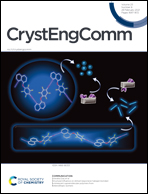Contact map based crystal structure prediction using global optimization†
Abstract
Crystal structure prediction is now playing an increasingly important role in the discovery of new materials or crystal engineering. Global optimization methods such as genetic algorithms (GAs) and particle swarm optimization have been combined with first-principles free energy calculations to predict crystal structures given the composition or only a chemical system. While these approaches can exploit certain crystal patterns such as symmetry and periodicity in their search process, they usually do not exploit the large amount of implicit rules and constraints of atom configurations embodied in the large number of known crystal structures. They currently can only handle crystal structure prediction of relatively small systems. Inspired by the knowledge-rich protein structure prediction approach, herein we explore whether known geometric constraints such as the atomic contact map of a target crystal material can help predict its structure given its space group information. We propose a global optimization-based algorithm, CMCrystal, for crystal structure (atomic coordinates) reconstruction based on atomic contact maps. Based on extensive experiments using six global optimization algorithms, we show that it is viable to reconstruct the crystal structure given the atomic contact map for some crystal materials, but more geometric or physicochemical constraints are needed to achieve the successful reconstruction of other materials.



 Please wait while we load your content...
Please wait while we load your content...
